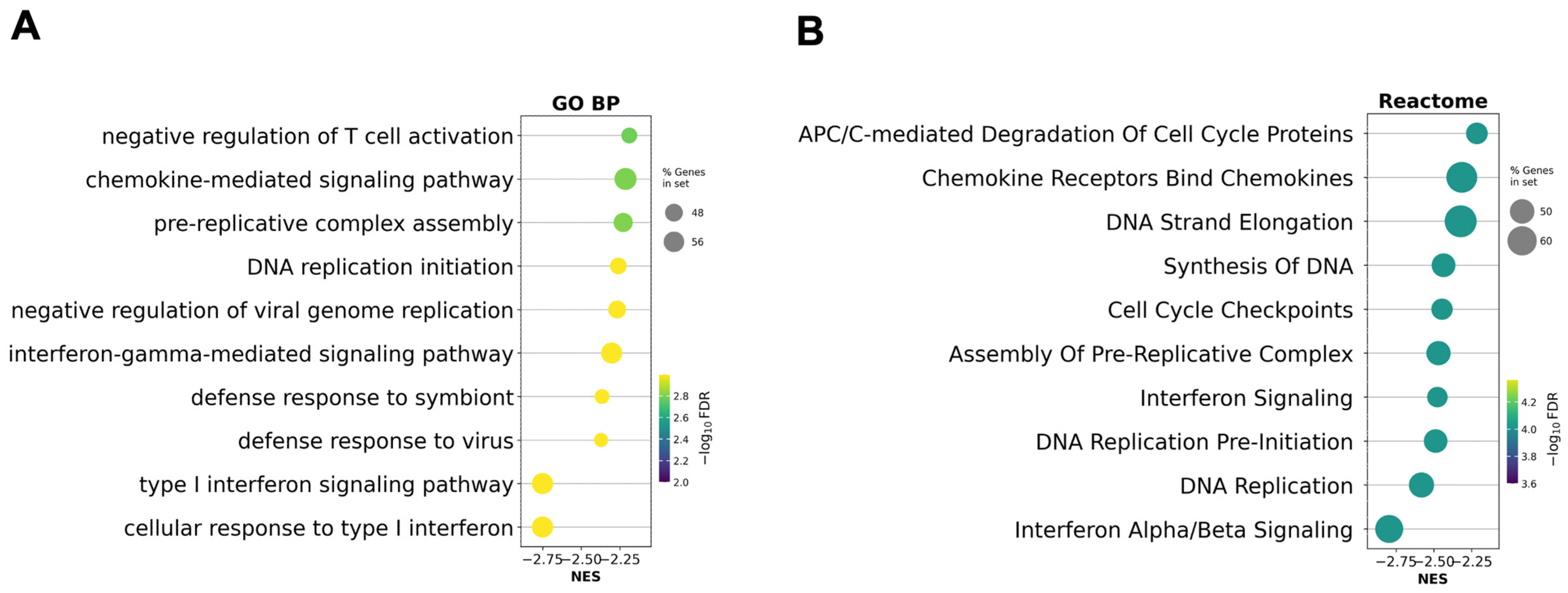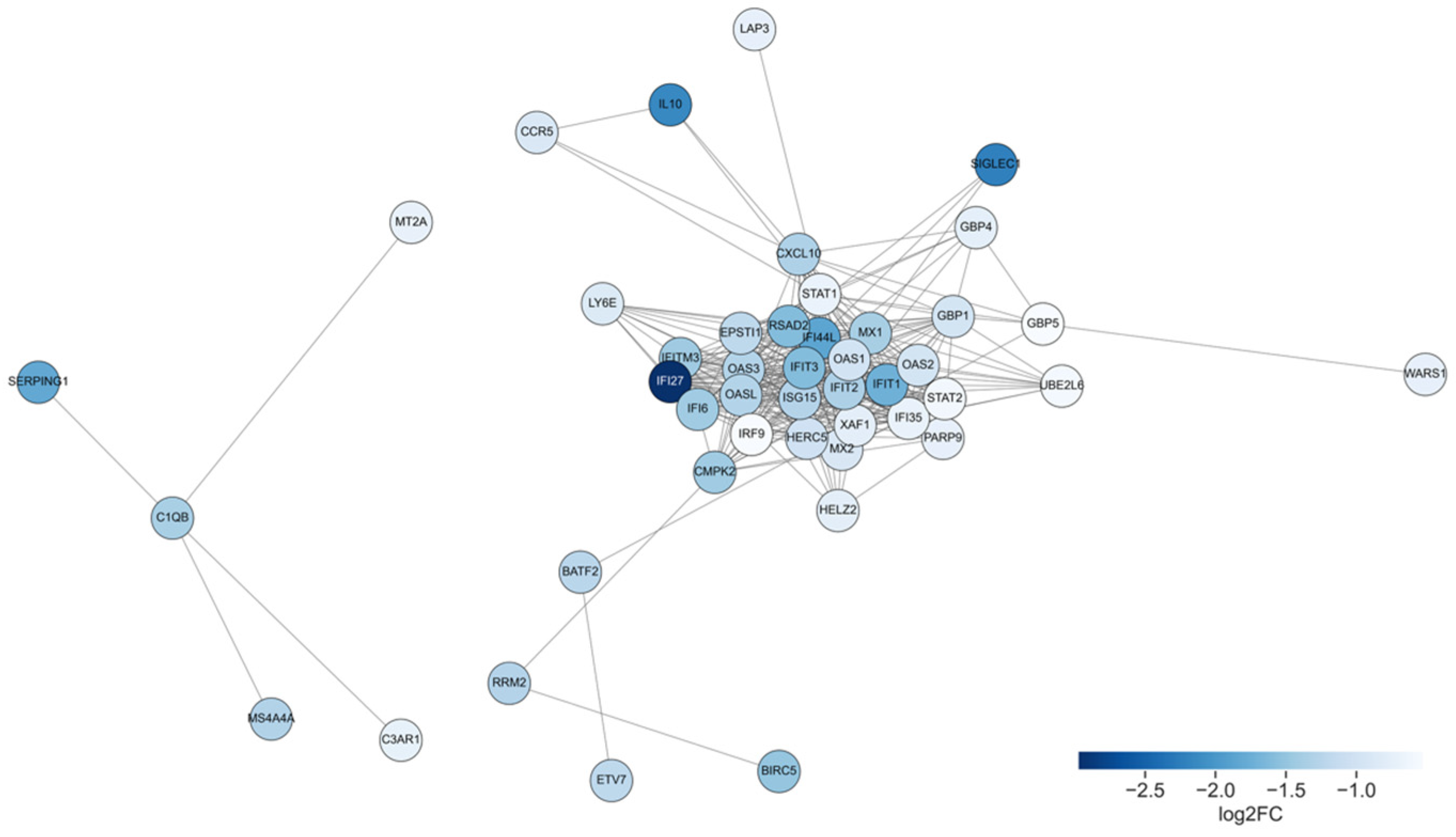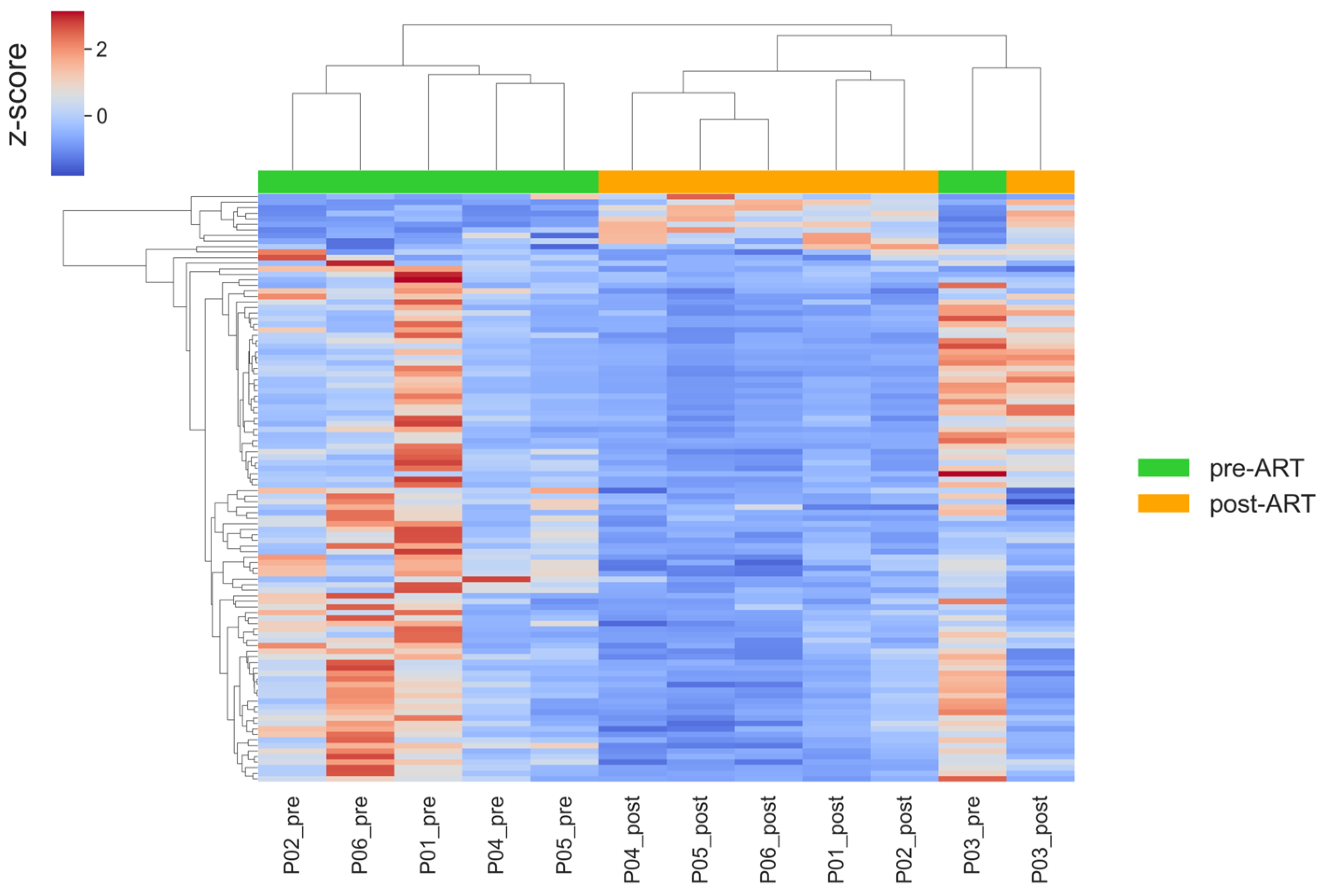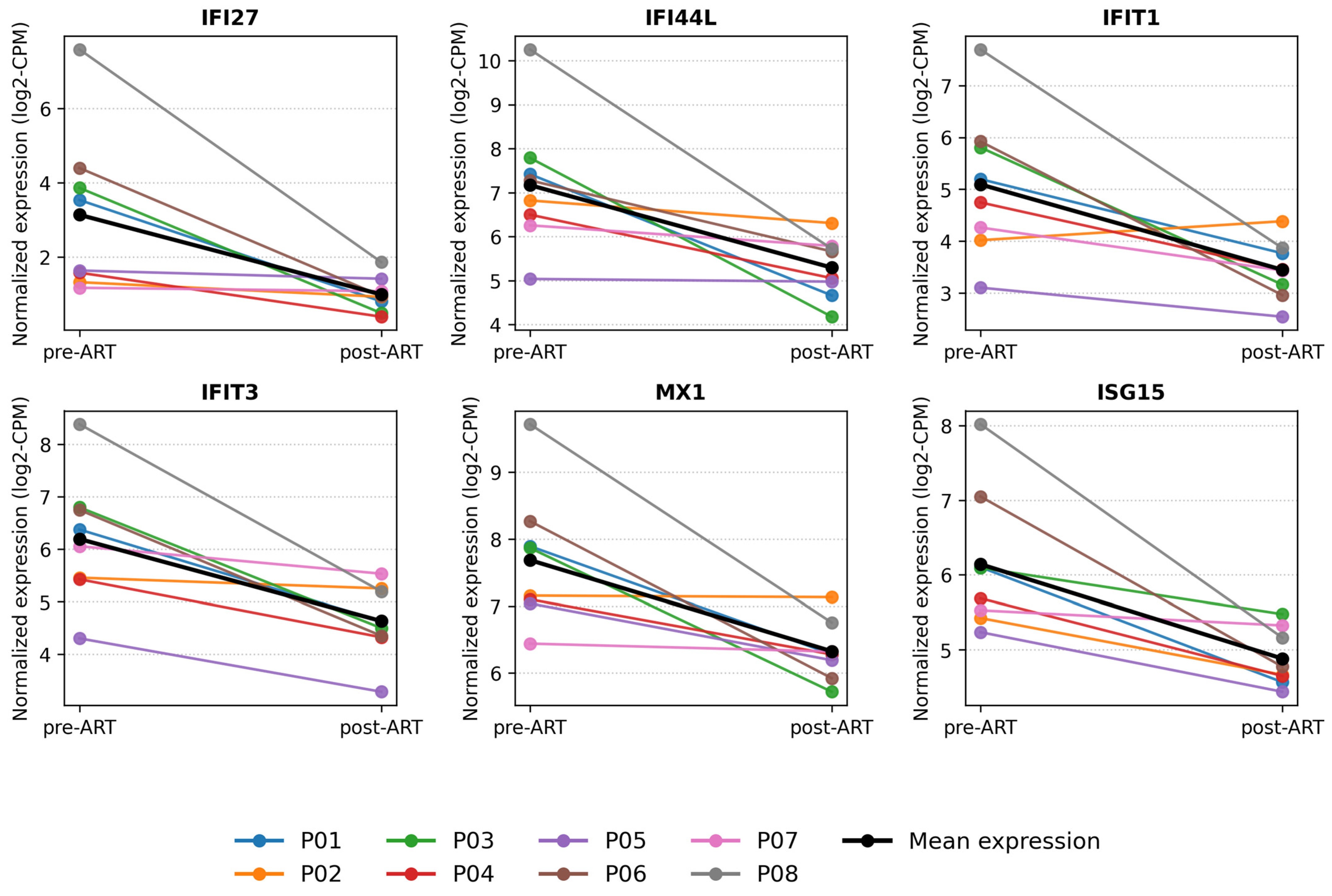Early Transcriptomic Signatures of Immune Response Modulation Following Antiretroviral Therapy in HIV-Infected Patients
Abstract
1. Introduction
2. Results
2.1. Identification of Differentially Expressed Genes
2.2. Gene Set Enrichment Analysis
2.3. Results of PPI Network Analysis
2.4. Clustering Analysis
2.5. Within-Subject Expression Dynamics of Interferon-Stimulated Genes Before and After ART
3. Discussion
4. Materials and Methods
4.1. Clinical Characteristics
4.2. RNA-Seq Data Generation and Preprocessing
4.3. Differential Gene Expression Analysis
4.4. PPI Network Analysis
5. Conclusions
Supplementary Materials
Author Contributions
Funding
Institutional Review Board Statement
Informed Consent Statement
Data Availability Statement
Acknowledgments
Conflicts of Interest
Abbreviations
| HIV | Human Immunodeficiency Virus |
| ART | Antiretroviral Therapy |
| PBMCs | Peripheral Blood Mononuclear Cells |
| TDF | Tenofovir Disoproxil Fumarate |
| 3TC | Lamivudine |
| DTG | Dolutegravir |
| RNA-seq | RNA sequencing |
| DEGs | Differentially Expressed Genes |
| GSEA | Gene Set Enrichment Analysis |
| PCA | Principal Component Analysis |
| PPI | Protein–Protein Interaction |
| STRING | Search Tool for the Retrieval of Interacting Genes/Proteins |
| GO | Gene Ontology |
| NES | Normalized Enrichment Score |
| FDR | False Discovery Rate |
| DAVID | Database for Annotation, Visualization and Integrated Discovery |
| ISGs | Interferon-Stimulated Genes |
| IFN-I | Type I Interferon |
| JAK–STAT | Janus Kinase–Signal Transducer and Activator of Transcription |
References
- World Health Organization. HIV Statistics, Globally and by WHO Region. Available online: https://cdn.who.int/media/docs/default-source/hq-hiv-hepatitis-and-stis-library/who-ias-hiv-statistics_2025-new.pdf?sfvrsn=5023deae_15 (accessed on 19 September 2025).
- Vidya Vijayan, K.K.; Karthigeyan, K.P.; Tripathi, S.P.; Hanna, L.E. Pathophysiology of CD4+ T-Cell Depletion in HIV-1 and HIV-2 Infections. Front. Immunol. 2017, 8, 580. [Google Scholar] [CrossRef] [PubMed]
- Boyd, M.A. Improvements in Antiretroviral Therapy Outcomes over Calendar Time. Curr. Opin. HIV AIDS 2009, 4, 194–199. [Google Scholar] [CrossRef] [PubMed]
- Antiretroviral Therapy Cohort Collaboration. Life Expectancy of Individuals on Combination Antiretroviral Therapy in High-Income Countries: A Collaborative Analysis of 14 Cohort Studies. Lancet 2008, 372, 293–299. [Google Scholar] [CrossRef] [PubMed]
- Stubbington, M.J.T.; Rozenblatt-Rosen, O.; Regev, A.; Teichmann, S.A. Single-Cell Transcriptomics to Explore the Immune System in Health and Disease. Science 2017, 358, 58–63. [Google Scholar] [CrossRef] [PubMed]
- Barton, A.J.; Hill, J.; Pollard, A.J.; Blohmke, C.J. Transcriptomics in Human Challenge Models. Front. Immunol. 2017, 8, 1839. [Google Scholar] [CrossRef] [PubMed]
- Massanella, M.; Singhania, A.; Beliakova-Bethell, N.; Pier, R.; Lada, S.M.; White, C.H.; Pérez-Santiago, J.; Blanco, J.; Richman, D.D.; Little, S.J.; et al. Differential Gene Expression in HIV-Infected Individuals Following ART. Antivir. Res. 2013, 100, 420–428. [Google Scholar] [CrossRef] [PubMed]
- Boulware, D.R.; Meya, D.B.; Bergemann, T.L.; Williams, D.; Vlasova-St. Louis, I.A.; Rhein, J.; Staddon, J.; Kambugu, A.; Janoff, E.N.; Bohjanen, P.R. Antiretroviral Therapy Down-Regulates Innate Antiviral Response Genes in Patients with AIDS in Sub-Saharan Africa. JAIDS J. Acquir. Immune Defic. Syndr. 2010, 55, 428–438. [Google Scholar] [CrossRef] [PubMed]
- Zhang, Z.; Zhang, L.; Shen, Y. Identification of Immune Features of HIV-Infected Patients with Antiretroviral Therapy through Bioinformatics Analysis. Virology 2022, 566, 69–74. [Google Scholar] [CrossRef] [PubMed]
- da Conceicao, V.N.; Dyer, W.B.; Gandhi, K.; Gupta, P.; Saksena, N.K. Genome-Wide Analysis of Primary Peripheral Blood Mononuclear Cells from HIV + Patients-Pre-and Post- HAART Show Immune Activation and Inflammation the Main Drivers of Host Gene Expression. Mol. Cell. Ther. 2014, 2, 11. [Google Scholar] [CrossRef] [PubMed]
- Wang, Z.; Gerstein, M.; Snyder, M. RNA-Seq: A Revolutionary Tool for Transcriptomics. Nat. Rev. Genet. 2009, 10, 57–63. [Google Scholar] [CrossRef] [PubMed]
- Zhou, Y.; Huang, Y.; Chen, X.; Chen, T.; Hu, W.; Hou, W.; Zhang, Q.; Xiong, Y. Transcriptomic Study Reveals Changes of lncRNAs in PBMCs from HIV-1 Patients before and after ART. Sci. Rep. 2023, 13, 22493. [Google Scholar] [CrossRef] [PubMed]
- Zhao, F.; Ma, J.; Huang, L.; Deng, Y.; Li, L.; Zhou, Y.; Li, J.; Li, S.; Jiang, H.; Yang, H.; et al. Comparative Transcriptome Analysis of PBMC from HIV Patients Pre- and Post-Antiretroviral Therapy. Meta Gene 2017, 12, 50–61. [Google Scholar] [CrossRef]
- Chung, L.M.; Ferguson, J.P.; Zheng, W.; Qian, F.; Bruno, V.; Montgomery, R.R.; Zhao, H. Differential Expression Analysis for Paired RNA-Seq Data. BMC Bioinform. 2013, 14, 110. [Google Scholar] [CrossRef] [PubMed]
- Hoenigl, M.; Chaillon, A.; Moore, D.J.; Morris, S.R.; Mehta, S.R.; Gianella, S.; Amico, K.R.; Little, S.J. Rapid HIV Viral Load Suppression in Those Initiating Antiretroviral Therapy at First Visit after HIV Diagnosis. Sci. Rep. 2016, 6, 32947. [Google Scholar] [CrossRef] [PubMed]
- Chirnet, A.T.; Habtewold, E.M.; Aman, H.; Wakwoya, E.B.; Workie, S.G. Time to Viral Load Suppression and Its Predictors among People Living with HIV on Antiretroviral Therapy in Gebi Resu Zone, Afar Region, Ethiopia, 2023. Front. Public Health 2024, 12, 1384787. [Google Scholar] [CrossRef] [PubMed]
- Serrano-Villar, S.; Sainz, T.; Lee, S.A.; Hunt, P.W.; Sinclair, E.; Shacklett, B.L.; Ferre, A.L.; Hayes, T.L.; Somsouk, M.; Hsue, P.Y.; et al. HIV-Infected Individuals with Low CD4/CD8 Ratio despite Effective Antiretroviral Therapy Exhibit Altered T Cell Subsets, Heightened CD8+ T Cell Activation, and Increased Risk of Non-AIDS Morbidity and Mortality. PLoS Pathog. 2014, 10, e1004078. [Google Scholar] [CrossRef] [PubMed]
- Winston, A.; Jose, S.; Fisher, M.; Walsh, J.; Nelson, M.; Gilson, R.; Post, F.; Johnson, M.; Leen, C.; Chadwick, D.; et al. Host, Disease, and Antiretroviral Factors Are Associated with Normalization of the CD4:CD8 Ratio after Initiating Antiretroviral Therapy. J. Allergy Clin. Immunol. 2015, 136, 1682–1685.e1. [Google Scholar] [CrossRef] [PubMed]
- Sherman, B.T.; Hao, M.; Qiu, J.; Jiao, X.; Baseler, M.W.; Lane, H.C.; Imamichi, T.; Chang, W. DAVID: A Web Server for Functional Enrichment Analysis and Functional Annotation of Gene Lists (2021 Update). Nucleic Acids Res. 2022, 50, W216–W221. [Google Scholar] [CrossRef] [PubMed]
- Huang, D.W.; Sherman, B.T.; Lempicki, R.A. Systematic and Integrative Analysis of Large Gene Lists Using DAVID Bioinformatics Resources. Nat. Protoc. 2009, 4, 44–57. [Google Scholar] [CrossRef] [PubMed]
- Siegel, D.A.; Thanh, C.; Wan, E.; Hoh, R.; Hobbs, K.; Pan, T.; Gibson, E.A.; Kroetz, D.L.; Martin, J.; Hecht, F.; et al. Host Variation in Type I Interferon Signaling Genes (MX1), C–C Chemokine Receptor Type 5 Gene, and Major Histocompatibility Complex Class I Alleles in Treated HIV+ Noncontrollers Predict Viral Reservoir Size. AIDS 2023, 37, 477–488. [Google Scholar] [CrossRef] [PubMed]
- Betancor, G.; Jimenez-Guardeño, J.M.; Lynham, S.; Antrobus, R.; Khan, H.; Sobala, A.; Dicks, M.D.J.; Malim, M.H. MX2-Mediated Innate Immunity against HIV-1 Is Regulated by Serine Phosphorylation. Nat. Microbiol. 2021, 6, 1031–1042, Erratum in Nat. Microbiol. 2021, 6, 1211. [Google Scholar] [CrossRef] [PubMed]
- Arts, E.J.; Hazuda, D.J. HIV-1 Antiretroviral Drug Therapy. Cold Spring Harb. Perspect. Med. 2012, 2, a007161. [Google Scholar] [CrossRef] [PubMed]
- Soper, A.; Kimura, I.; Nagaoka, S.; Konno, Y.; Yamamoto, K.; Koyanagi, Y.; Sato, K. Type I Interferon Responses by HIV-1 Infection: Association with Disease Progression and Control. Front. Immunol. 2018, 8, 1823. [Google Scholar] [CrossRef] [PubMed]
- Li, Y.; Sun, B.; Esser, S.; Jessen, H.; Streeck, H.; Widera, M.; Yang, R.; Dittmer, U.; Sutter, K. Expression Pattern of Individual IFNA Subtypes in Chronic HIV Infection. J. Interferon Cytokine Res. 2017, 37, 541–549. [Google Scholar] [CrossRef] [PubMed]
- Zhen, A.; Rezek, V.; Youn, C.; Lam, B.; Chang, N.; Rick, J.; Carrillo, M.; Martin, H.; Kasparian, S.; Syed, P.; et al. Targeting Type I Interferon–Mediated Activation Restores Immune Function in Chronic HIV Infection. J. Clin. Investig. 2016, 127, 260–268. [Google Scholar] [CrossRef] [PubMed]
- van Pul, L.; van Dort, K.A.; Girigorie, A.F.; Maurer, I.; Harskamp, A.M.; Kootstra, N.A. Human Immunodeficiency Virus–Induced Interferon-Stimulated Gene Expression Is Associated With Monocyte Activation and Predicts Viral Load. Open Forum Infect. Dis. 2024, 11, ofae434. [Google Scholar] [CrossRef] [PubMed]
- World Health Organization. Consolidated Guidelines on HIV Prevention, Testing, Treatment, Service Delivery and Monitoring: Recommendations for a Public Health Approach; World Health Organization: Geneva, Switzerland, 2021; ISBN 978-92-4-003159-3. [Google Scholar]
- Eholié, S.P.; Badje, A.; Kouame, G.M.; N’takpe, J.-B.; Moh, R.; Danel, C.; Anglaret, X. Antiretroviral Treatment Regardless of CD4 Count: The Universal Answer to a Contextual Question. AIDS Res. Ther. 2016, 13, 27. [Google Scholar] [CrossRef] [PubMed]
- Song, A.; Liu, X.; Huang, X.; Meyers, K.; Oh, D.-Y.; Hou, J.; Xia, W.; Su, B.; Wang, N.; Lu, X.; et al. From CD4-Based Initiation to Treating All HIV-Infected Adults Immediately: An Evidence-Based Meta-Analysis. Front. Immunol. 2018, 9, 212. [Google Scholar] [CrossRef] [PubMed]
- Department of Health and Human Services Panel on Antiretroviral Guidelines for Adults and Adolescents. Guidelines for the Use of Antiretroviral Agents in Adults and Adolescents With HIV. 2024. Available online: https://clinicalinfo.hiv.gov/en/guidelines/hiv-clinical-guidelines-adult-and-adolescent-arv (accessed on 10 July 2025).
- Ron, R.; Moreno, E.; Martínez-Sanz, J.; Brañas, F.; Sainz, T.; Moreno, S.; Serrano-Villar, S. CD4/CD8 Ratio During Human Immunodeficiency Virus Treatment: Time for Routine Monitoring? Clin. Infect. Dis. 2023, 76, 1688–1696. [Google Scholar] [CrossRef] [PubMed]
- Ron, R.; Martínez-Sanz, J.; Herrera, S.; Ramos-Ruperto, L.; Díez-Vidal, A.; Sainz, T.; Álvarez-Díaz, N.; Correa-Pérez, A.; Muriel, A.; López-Alcalde, J.; et al. CD4/CD8 Ratio and CD8+ T-Cell Count as Prognostic Markers for Non-AIDS Mortality in People Living with HIV. A Systematic Review and Meta-Analysis. Front. Immunol. 2024, 15, 1343124, Erratum in Front. Immunol. 2024, 15, 1383117. [Google Scholar] [CrossRef]
- Martin-Gayo, E.; Gao, C.; Calvet-Mirabent, M.; Ouyang, Z.; Lichterfeld, M.; Yu, X.G. Cooperation between cGAS and RIG-I Sensing Pathways Enables Improved Innate Recognition of HIV-1 by Myeloid Dendritic Cells in Elite Controllers. Front. Immunol. 2022, 13, 1017164. [Google Scholar] [CrossRef] [PubMed]
- McCauley, S.M.; Kim, K.; Nowosielska, A.; Dauphin, A.; Yurkovetskiy, L.; Diehl, W.E.; Luban, J. Intron-Containing RNA from the HIV-1 Provirus Activates Type I Interferon and Inflammatory Cytokines. Nat. Commun. 2018, 9, 5305. [Google Scholar] [CrossRef] [PubMed]
- Zahoor, M.A.; Xue, G.; Sato, H.; Murakami, T.; Takeshima, S.; Aida, Y. HIV-1 Vpr Induces Interferon-Stimulated Genes in Human Monocyte-Derived Macrophages. PLoS ONE 2014, 9, e106418. [Google Scholar] [CrossRef] [PubMed]
- Chang, J.J.; Woods, M.; Lindsay, R.J.; Doyle, E.H.; Griesbeck, M.; Chan, E.S.; Robbins, G.K.; Bosch, R.J.; Altfeld, M. Higher Expression of Several Interferon-Stimulated Genes in HIV-1-Infected Females After Adjusting for the Level of Viral Replication. J. Infect. Dis. 2013, 208, 830–838. [Google Scholar] [CrossRef] [PubMed]
- Boreland, A.J.; Stillitano, A.C.; Lin, H.-C.; Abbo, Y.; Hart, R.P.; Jiang, P.; Pang, Z.P.; Rabson, A.B. Sustained Type I Interferon Signaling after Human Immunodeficiency Virus Type 1 Infection of Human iPSC Derived Microglia and Cerebral Organoids. iScience 2024, 27, 109628. [Google Scholar] [CrossRef] [PubMed]
- Scagnolari, C.; Monteleone, K.; Selvaggi, C.; Pierangeli, A.; D’Ettorre, G.; Mezzaroma, I.; Turriziani, O.; Gentile, M.; Vullo, V.; Antonelli, G. ISG15 Expression Correlates with HIV-1 Viral Load and with Factors Regulating T Cell Response. Immunobiology 2016, 221, 282–290. [Google Scholar] [CrossRef] [PubMed]
- Sugawara, S.; El-Diwany, R.; Cohen, L.K.; Rousseau, K.E.; Williams, C.Y.K.; Veenhuis, R.T.; Mehta, S.H.; Blankson, J.N.; Thomas, D.L.; Cox, A.L.; et al. People with HIV-1 Demonstrate Type 1 Interferon Refractoriness Associated with Upregulated USP18. J. Virol. 2021, 95, e01777-20. [Google Scholar] [CrossRef] [PubMed]
- Marschang, P.; Ebenbichler, C.F.; Dierich, M.P. HIV and Complement: Role of the Complement System in HIV Infection. Int. Arch. Allergy Immunol. 1994, 103, 113–117. [Google Scholar] [CrossRef] [PubMed]
- Stoiber, H.; Clivio, A.; Dierich, M.P. Role of Complement in HIV Infection. Annu. Rev. Immunol. 1997, 15, 649–674. [Google Scholar] [CrossRef] [PubMed]
- Prohászka, Z.; Német, K.; Csermely, P.; Hudecz, F.; Mezõ, G.; Füst, G. Defensins Purified from Human Granulocytes Bind C1q and Activate the Classical Complement Pathway like the Transmenbrane Glycoprotein Gq41 of HIV-1. Mol. Immunol. 1997, 34, 809–816. [Google Scholar] [CrossRef] [PubMed]
- Sanfilippo, C.; Cambria, D.; Longo, A.; Palumbo, M.; Avola, R.; Pinzone, M.; Nunnari, G.; Condorelli, F.; Musumeci, G.; Imbesi, R.; et al. SERPING1 mRNA Overexpression in Monocytes from HIV+ Patients. Inflamm. Res. 2017, 66, 1107–1116. [Google Scholar] [CrossRef] [PubMed]
- Narasipura, S.D.; Zayas, J.P.; Ash, M.K.; Reyes, A.F.; Shull, T.; Gambut, S.; Szczerkowski, J.L.A.; McKee, C.; Schneider, J.R.; Lorenzo-Redondo, R.; et al. Inflammatory Responses Revealed through HIV Infection of Microglia-Containing Cerebral Organoids. J. Neuroinflamm. 2025, 22, 36. [Google Scholar] [CrossRef] [PubMed]
- Kosmider, E.; Wallner, J.; Gervassi, A.; Bender Ignacio, R.A.; Pinto-Santini, D.; Gornalusse, G.; Pandey, U.; Hladik, F.; Edlefsen, P.T.; Lama, J.R.; et al. Observational Study of Effects of HIV Acquisition and Antiretroviral Treatment on Biomarkers of Systemic Immune Activation. PLoS ONE 2024, 19, e0288895. [Google Scholar] [CrossRef] [PubMed]
- De Clercq, J.; De Scheerder, M.-A.; Mortier, V.; Verhofstede, C.; Vandecasteele, S.J.; Allard, S.D.; Necsoi, C.; De Wit, S.; Gerlo, S.; Vandekerckhove, L. Longitudinal Patterns of Inflammatory Mediators after Acute HIV Infection Correlate to Intact and Total Reservoir. Front. Immunol. 2024, 14, 1337316. [Google Scholar] [CrossRef] [PubMed]
- Alagaratnam, J.; Stöhr, W.; Hamlyn, E.; Porter, K.; Toombs, J.; Heslegrave, A.; Zetterberg, H.; Gisslén, M.; Underwood, J.; Schechter, M.; et al. Impact of Interrupting Antiretroviral Therapy Started during Primary HIV-1 Infection on Plasma Neurofilament Light Chain Protein, a Marker of Neuronal Injury: The SPARTAC Trial. J. Virus Erad. 2024, 10, 100381. [Google Scholar] [CrossRef] [PubMed]
- Salgado, M.; Gálvez, C.; Nijhuis, M.; Kwon, M.; Cardozo-Ojeda, E.F.; Badiola, J.; Gorman, M.J.; Huyveneers, L.E.P.; Urrea, V.; Bandera, A.; et al. Dynamics of Virological and Immunological Markers of HIV Persistence after Allogeneic Haematopoietic Stem-Cell Transplantation in the IciStem Cohort: A Prospective Observational Cohort Study. Lancet HIV 2024, 11, e389–e405. [Google Scholar] [CrossRef] [PubMed]
- Bosinger, S.E.; Utay, N.S. Type I Interferon: Understanding Its Role in HIV Pathogenesis and Therapy. Curr. HIV/AIDS Rep. 2015, 12, 41–53. [Google Scholar] [CrossRef] [PubMed]
- Gondim, M.V.P.; Sherrill-Mix, S.; Bibollet-Ruche, F.; Russell, R.M.; Trimboli, S.; Smith, A.G.; Li, Y.; Liu, W.; Avitto, A.N.; DeVoto, J.C.; et al. Heightened Resistance to Host Type 1 Interferons Characterizes HIV-1 at Transmission and after Antiretroviral Therapy Interruption. Sci. Transl. Med. 2021, 13, eabd8179. [Google Scholar] [CrossRef] [PubMed]
- Iyer, S.S.; Bibollet-Ruche, F.; Sherrill-Mix, S.; Learn, G.H.; Plenderleith, L.; Smith, A.G.; Barbian, H.J.; Russell, R.M.; Gondim, M.V.P.; Bahari, C.Y.; et al. Resistance to Type 1 Interferons Is a Major Determinant of HIV-1 Transmission Fitness. Proc. Natl. Acad. Sci. USA 2017, 114, E590–E599. [Google Scholar] [CrossRef] [PubMed]
- Bessudo, A.; Rassenti, L.; Havlir, D.; Richman, D.; Feigal, E.; Kipps, T.J. Aberrant and Unstable Expression of Immunoglobulin Genes in Persons Infected With Human Immunodeficiency Virus. Blood 1998, 92, 1317–1323. [Google Scholar] [CrossRef] [PubMed]
- De Milito, A.; Nilsson, A.; Titanji, K.; Thorstensson, R.; Reizenstein, E.; Narita, M.; Grutzmeier, S.; Sönnerborg, A.; Chiodi, F. Mechanisms of Hypergammaglobulinemia and Impaired Antigen-Specific Humoral Immunity in HIV-1 Infection. Blood 2004, 103, 2180–2186. [Google Scholar] [CrossRef] [PubMed]
- Morris, L.; Binley, J.M.; Clas, B.A.; Bonhoeffer, S.; Astill, T.P.; Kost, R.; Hurley, A.; Cao, Y.; Markowitz, M.; Ho, D.D.; et al. HIV-1 Antigen–Specific and –Nonspecific B Cell Responses Are Sensitive to Combination Antiretroviral Therapy. J. Exp. Med. 1998, 188, 233–245. [Google Scholar] [CrossRef] [PubMed]
- Notermans, D.W.; de Jong, J.J.; Goudsmit, J.; Bakker, M.; Roos, M.T.L.; Nijholt, L.; Cremers, J.; Hellings, J.-A.; Danner, S.A.; de Ronde, A. Potent Antiretroviral Therapy Initiates Normalization of Hypergammaglobulinemia and a Decline in HIV Type 1-Specific Antibody Responses. AIDS Res. Hum. Retroviruses 2001, 17, 1003–1008. [Google Scholar] [CrossRef] [PubMed]
- Badura, R.; Foxall, R.B.; Ligeiro, D.; Rocha, M.; Godinho-Santos, A.; Trombetta, A.C.; Sousa, A.E. Early ART in Acute HIV-1 Infection: Impact on the B-Cell Compartment. Front. Cell. Infect. Microbiol. 2020, 10, 347. [Google Scholar] [CrossRef] [PubMed]
- Gupta, A.; Brown, C.; Zheng, Y.-H.; Adami, C. Differentially-Expressed Pseudogenes in HIV-1 Infection. Viruses 2015, 7, 5191–5205. [Google Scholar] [CrossRef] [PubMed]
- Carlton, M.B.L.; Colledge, W.H.; Evans, M.J. Generation of a Pseudogene during Retroviral Infection. Mamm. Genome 1995, 6, 90–95. [Google Scholar] [CrossRef] [PubMed]
- Ellwanger, J.H.; Kulmann-Leal, B.; Ziliotto, M.; Chies, J.A.B. HIV Infection, Chromosome Instability, and Micronucleus Formation. Viruses 2023, 15, 155. [Google Scholar] [CrossRef] [PubMed]
- Tonner, P.; Srinivasasainagendra, V.; Zhang, S.; Zhi, D. Detecting Transcription of Ribosomal Protein Pseudogenes in Diverse Human Tissues from RNA-Seq Data. BMC Genom. 2012, 13, 412. [Google Scholar] [CrossRef] [PubMed]
- Zhang, Z.; Harrison, P.; Gerstein, M. Identification and Analysis of Over 2000 Ribosomal Protein Pseudogenes in the Human Genome. Genome Res. 2002, 12, 1466–1482. [Google Scholar] [CrossRef] [PubMed]
- Xu, J.; Ren, Y.; Lu, J.; Qin, F.; Yang, D.; Tang, C.; Yang, Y.; Xu, J.; Liu, T.; Yi, P. Genome-wide Profiling of N6-methyladenosine-modified Pseudogene-derived Long Noncoding RNAs Reveals the Tumour-promoting and Innate Immune-restraining Function of RPS15AP12 in Ovarian Cancer. Clin. Transl. Med. 2025, 15, e70249. [Google Scholar] [CrossRef] [PubMed]
- Wilson, D.N.; Nierhaus, K.H. Ribosomal Proteins in the Spotlight. Crit. Rev. Biochem. Mol. Biol. 2005, 40, 243–267. [Google Scholar] [CrossRef] [PubMed]
- Zhou, X.; Liao, W.-J.; Liao, J.-M.; Liao, P.; Lu, H. Ribosomal Proteins: Functions beyond the Ribosome. J. Mol. Cell Biol. 2015, 7, 92–104. [Google Scholar] [CrossRef] [PubMed]
- Guan, J.; Han, S.; Wu, J.; Zhang, Y.; Bai, M.; Abdullah, S.W.; Sun, S.; Guo, H. Ribosomal Protein L13 Participates in Innate Immune Response Induced by Foot-and-Mouth Disease Virus. Front. Immunol. 2021, 12, 616402. [Google Scholar] [CrossRef] [PubMed]
- Cristiano, L. The Pseudogenes of Eukaryotic Translation Elongation Factors (EEFs): Role in Cancer and Other Human Diseases. Genes Dis. 2022, 9, 941–958. [Google Scholar] [CrossRef] [PubMed]
- Zhang, W.; Wang, J.; Shan, C. The eEF1A Protein in Cancer: Clinical Significance, Oncogenic Mechanisms, and Targeted Therapeutic Strategies. Pharmacol. Res. 2024, 204, 107195. [Google Scholar] [CrossRef] [PubMed]
- Brochado-Kith, O.; Martinez, I.; Berenguer, J.; Medrano, L.M.; González-García, J.; Garcia-Broncano, P.; Jiménez-Sousa, M.Á.; Carrero, A.; Hontañón, V.; Muñoz-Fernández, M.Á.; et al. Near Normalization of Peripheral Blood Markers in HIV-Infected Patients on Long-Term Suppressive Antiretroviral Therapy: A Case–Control Study. AIDS 2020, 34, 1891–1897. [Google Scholar] [CrossRef] [PubMed]
- Nyström, S.; Govender, M.; Yap, S.H.; Kamarulzaman, A.; Rajasuriar, R.; Larsson, M. HIV-Infected Individuals on ART With Impaired Immune Recovery Have Altered Plasma Metabolite Profiles. Open Forum Infect. Dis. 2021, 8, ofab288. [Google Scholar] [CrossRef] [PubMed]
- Bovolenta, C.; Camorali, L.; Lorini, A.L.; Ghezzi, S.; Vicenzi, E.; Lazzarin, A.; Poli, G. Constitutive Activation of STATs Upon In Vivo Human Immunodeficiency Virus Infection. Blood 1999, 94, 4202–4209. [Google Scholar] [CrossRef] [PubMed]
- Zhao, G.; Liu, L.; Su, B.; Zhang, T.; Chen, P.; Li, W.; Wu, H. The Dynamic Changes of Interferon Lambdas Related Genes and Proteins in JAK/STAT Pathway in Both Acute and Chronic HIV-1 Infected Patients. AIDS Res. Ther. 2017, 14, 31. [Google Scholar] [CrossRef] [PubMed]
- Hirsch, H.H.; Kaufmann, G.; Sendi, P.; Battegay, M. Immune Reconstitution in HIV-Infected Patients. Clin. Infect. Dis. 2004, 38, 1159–1166. [Google Scholar] [CrossRef] [PubMed]
- Mendicino, C.C.P.; Moodie, E.E.M.; Guimarães, M.D.C.; Pádua, C.A.M.d. Immune Recovery after Antiretroviral Therapy Initiation: A Challenge for People Living with HIV in Brazil. Cad. De Saúde Pública 2021, 37, e00143520. [Google Scholar] [CrossRef] [PubMed]
- New York State Department of Health AIDS Institute. Primary Care for Adults with HIV: Virologic and Immunologic Monitoring in HIV Care. 2025. Available online: https://www.hivguidelines.org/guideline/hiv-primary-care/ (accessed on 8 August 2025).
- Cao, W.; Mehraj, V.; Kaufmann, D.E.; Li, T.; Routy, J. Elevation and Persistence of CD8 T-cells in HIV Infection: The Achilles Heel in the ART Era. J. Int. AIDS Soc. 2016, 19, 20697. [Google Scholar] [CrossRef] [PubMed]
- Mudd, J.C.; Lederman, M.M. CD8 T Cell Persistence in Treated HIV Infection. Curr. Opin. HIV AIDS 2014, 9, 500–505. [Google Scholar] [CrossRef] [PubMed]
- Parker, E.; Judge, M.A.; Pastor, L.; Fuente-Soro, L.; Jairoce, C.; Carter, K.W.; Anderson, D.; Mandomando, I.; Clifford, H.D.; Naniche, D.; et al. Gene Dysregulation in Acute HIV-1 Infection—Early Transcriptomic Analysis Reveals the Crucial Biological Functions Affected. Front. Cell. Infect. Microbiol. 2023, 13, 1074847. [Google Scholar] [CrossRef] [PubMed]
- Hoffmann, M.; Willruth, L.-L.; Dietrich, A.; Lee, H.K.; Knabl, L.; Trummer, N.; Baumbach, J.; Furth, P.A.; Hennighausen, L.; List, M. Blood Transcriptomics Analysis Offers Insights into Variant-Specific Immune Response to SARS-CoV-2. Sci. Rep. 2024, 14, 2808. [Google Scholar] [CrossRef] [PubMed]
- Fang, Z.; Liu, X.; Peltz, G. GSEApy: A Comprehensive Package for Performing Gene Set Enrichment Analysis in Python. Bioinformatics 2023, 39, btac757. [Google Scholar] [CrossRef] [PubMed]
- Aleksander, S.A.; Balhoff, J.; Carbon, S.; Cherry, J.M.; Drabkin, H.J.; Ebert, D.; Feuermann, M.; Gaudet, P.; Harris, N.L.; Hill, D.P.; et al. The Gene Ontology Knowledgebase in 2023. Genetics 2023, 224, iyad031. [Google Scholar] [CrossRef] [PubMed]
- Milacic, M.; Beavers, D.; Conley, P.; Gong, C.; Gillespie, M.; Griss, J.; Haw, R.; Jassal, B.; Matthews, L.; May, B.; et al. The Reactome Pathway Knowledgebase 2024. Nucleic Acids Res. 2024, 52, D672–D678. [Google Scholar] [CrossRef] [PubMed]
- Szklarczyk, D.; Kirsch, R.; Koutrouli, M.; Nastou, K.; Mehryary, F.; Hachilif, R.; Gable, A.L.; Fang, T.; Doncheva, N.T.; Pyysalo, S.; et al. The STRING Database in 2023: Protein–Protein Association Networks and Functional Enrichment Analyses for Any Sequenced Genome of Interest. Nucleic Acids Res. 2023, 51, D638–D646. [Google Scholar] [CrossRef] [PubMed]








| Term | Count | % of Genes | p-Value | Fold Enrichment | FDR |
|---|---|---|---|---|---|
| Antiviral defense | 22 | 32.87 | 2.85 × 10−27 | 33.64 | 9.99 × 10−26 |
| Defense response to virus | 23 | 34.33 | 1.35 × 10−26 | 29.05 | 6.02 × 10−24 |
| Immunity | 31 | 46.27 | 9.08 × 10−19 | 6.63 | 1.59 × 10−17 |
| Innate immunity | 23 | 34.33 | 5.81 × 10−18 | 11.18 | 6.78 × 10−17 |
| Negative regulation of viral genome replication | 10 | 14.92 | 1.38 × 10−14 | 69.17 | 3.08 × 10−12 |
| Response to virus | 12 | 17.91 | 6.59 × 10−14 | 32.61 | 9.80 × 10−12 |
| Innate immune response | 19 | 28.36 | 1.45 × 10−13 | 10.15 | 1.61 × 10−11 |
| Interleukin-27-mediated signaling pathway | 6 | 8.96 | 1.67 × 10−11 | 228.26 | 1.49 × 10−9 |
| Antiviral innate immune response | 9 | 13.43 | 3.30 × 10−11 | 42.14 | 2.45 × 10−9 |
| Type I interferon-mediated signaling pathway | 8 | 11.94 | 2.35 × 10−10 | 48.70 | 1.50 × 10−8 |
| Label | Age (Years) | CD4+ T Lymphocyte (Count/µL) Before/After ART | CD8+ T Lymphocyte (Count/µL) Before/After ART | CD4/CD8 Ratio Before/After ART | Plasma Viral Load (Copies/mL) Before/After ART |
|---|---|---|---|---|---|
| P01 | 28 | 782/1070 | 1024/902 | 0.76/1.19 | 154,272/<20 |
| P02 | 34 | 540/802 | 1062/1055 | 0.51/0.76 | 64,368/<20 |
| P03 | 34 | 413/913 | 822/1161 | 0.50/0.79 | 27,942/<20 |
| P04 | 33 | 673/837 | 898/963 | 0.75/0.87 | 3825/<50 |
| P05 | 18 | 705/779 | 914/884 | 0.77/0.88 | 262,686/<50 |
| P06 | 35 | 543/582 | 1195/864 | 0.45/0.67 | 8821/<50 |
| P07 | 24 | 675/575 | 884/698 | 0.76/0.82 | 31,635/<50 |
| P08 | 26 | 642/516 | 576/1990 | 1.12/0.26 | 81,743/<50 |
Disclaimer/Publisher’s Note: The statements, opinions and data contained in all publications are solely those of the individual author(s) and contributor(s) and not of MDPI and/or the editor(s). MDPI and/or the editor(s) disclaim responsibility for any injury to people or property resulting from any ideas, methods, instructions or products referred to in the content. |
© 2025 by the authors. Licensee MDPI, Basel, Switzerland. This article is an open access article distributed under the terms and conditions of the Creative Commons Attribution (CC BY) license (https://creativecommons.org/licenses/by/4.0/).
Share and Cite
Stolbova, E.A.; Pokrovskaya, A.V.; Shemshura, A.B.; Kireev, D.E.; Lagunin, A.A.; Sobolev, B.N.; Ivanov, S.M.; Tarasova, O.A. Early Transcriptomic Signatures of Immune Response Modulation Following Antiretroviral Therapy in HIV-Infected Patients. Int. J. Mol. Sci. 2025, 26, 10678. https://doi.org/10.3390/ijms262110678
Stolbova EA, Pokrovskaya AV, Shemshura AB, Kireev DE, Lagunin AA, Sobolev BN, Ivanov SM, Tarasova OA. Early Transcriptomic Signatures of Immune Response Modulation Following Antiretroviral Therapy in HIV-Infected Patients. International Journal of Molecular Sciences. 2025; 26(21):10678. https://doi.org/10.3390/ijms262110678
Chicago/Turabian StyleStolbova, Ekaterina A., Anastasia V. Pokrovskaya, Andrey B. Shemshura, Dmitry E. Kireev, Alexey A. Lagunin, Boris N. Sobolev, Sergey M. Ivanov, and Olga A. Tarasova. 2025. "Early Transcriptomic Signatures of Immune Response Modulation Following Antiretroviral Therapy in HIV-Infected Patients" International Journal of Molecular Sciences 26, no. 21: 10678. https://doi.org/10.3390/ijms262110678
APA StyleStolbova, E. A., Pokrovskaya, A. V., Shemshura, A. B., Kireev, D. E., Lagunin, A. A., Sobolev, B. N., Ivanov, S. M., & Tarasova, O. A. (2025). Early Transcriptomic Signatures of Immune Response Modulation Following Antiretroviral Therapy in HIV-Infected Patients. International Journal of Molecular Sciences, 26(21), 10678. https://doi.org/10.3390/ijms262110678





